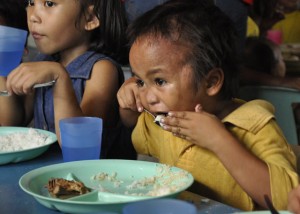There are about 2.8 million fewer hungry families in the Philippines and Malacañang was quick in saying that everything will be fine.
The figure was computed from results of a Social Weather Stations (SWS) survey conducted in the second quarter of the year that said 12.7 percent of households claimed to have experienced having nothing to eat at least once.
It was the lowest hunger number posted since the 12 percent recorded in May 2005, the pollster said.
Malacañang, in a statement, noted that the improving hunger numbers is a result of the government’s various programs, including the Pantawid Pamilyang Pilipino, or the conditional cash transfer program, which now covers over 4.4 million households.
“The program is an example of the government’s commitment to the Filipino people, as it embodies concrete investments in human development, empowering beneficiaries and their families to better care for themselves,” Palace deputy spokesman Abigail Valte said in a statement.
“This is consistent with recent survey results on unemployment and underemployment, which have gone down under this administration,” she added.
The SWS survey, the results of which had been first published in a business newspaper before its release to the public on Monday, was conducted from June 5 to 8 among 1,200 respondents.
According to the survey, second quarter hunger was down .8 of a point from the first quarter’s 13.5 percent (about three million families).
It was the third straight quarter for the hunger numbers to drop.
The survey also found that 10.8 percent or about 2.4 million families experienced “moderate hunger” (experienced hunger “only once” or “a few times”), and 1.9 percent (431,000 families) said they experienced “severe hunger” (experienced hunger “often” or “always”).
“Moderate” and “severe” hunger had eased only slightly from the first quarter, the SWS said.
Self-rated hunger in Metro Manila in the second quarter was the highest in three quarters at 18.3 percent (about 553,000 families), and up by 5.6 points from the first quarter’s 12.7 percent (about 382,000 families).
In the rest of Luzon, hunger dipped to 10.7 percent (estimated 1.1 million families) from 14.3 percent (about 1.4 million families) in the first quarter.
Balance Luzon hunger was its lowest level since the 9.7 percent in 2011’s second quarter.
Hunger in the Visayas was up at 11.7 percent (about 499,000 families) from 11 percent (470,000 families) in March.
In Mindanao, hunger was at 14.3 percent, the same as in March.
This was the lowest since 13 percent in September 2011.
Annual average hunger under the Aquino administration was at 19.1 percent in 2010, at 19.9 percent in 2011 and 2012, dipped to 19.5 percent in 2013 and was down to 18.3 percent in 2014.


